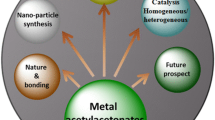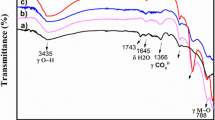Abstract
Transition metal complexes bonded to silica via silanes with β-diketonate groups can be used as packings for complexation gas chromatography or as immobilized homogenous metal complex catalysts. On basis of elemental analysis and the determination of surface area, possible structures of the complexes formed on the silica surface have been proposed. The possibility of using the immobilized complexes as catalysts has been indicated. Especially nickel complexes were taken into consideration. These immobilized complexes were used previously as packings for complexation gas chromatography.
Similar content being viewed by others
References
Allum, K. G., Hancock, R. D., Howell, I. V., Lester, T. E., McKenzie, S., Pitkethly, R. C., & Robinson, P. J. (1976). Supported transition metal complexes V.: Liquid phase catalytic hydrogenation of hexene-1, cyclohexane and isoprene under continuous flow conditions. Journal of Catalysis, 43, 331–338. DOI: 10.1016/0021-9517(76)90318-3.
Berendsen, G. E., Pikaart, K. A., & de Galon, L. (1980). Preparation of various bonded phases for HPLC using monochlorosilanes. Journal of Liquid Chromatography, 3, 1437–1464.
Buszewski, B., Jezierska, M., Welniak, M., & Berek, D. (1998). Survey and tretrends in the preparation of chemically bonded silica phases for liquid chromatographic analysis. Journal of High Resolution Chromatography, 21, 267–281. DOI: 10.1002/(SICI)1521-4168(19980501)21:5〈267::AID-JHRC267〉3.0.CO;2-7.
Cagniant, D. (1992). Complexation chromatography. New York: Marcel Dekker.
Čapka, M., Czakoová, M., Urbaniak, W., & Schubert, U. (1992). Hydrogenation and hydrosilylation activity of homogeneous and immoblilized dicarbonyl(2,4-pentanedionato)rhodium complexes. Journal of Molecular Catalysis, 74, 335–344. DOI: 10.1016/0304-5102(92)80251-B.
Charles, G., & Pawlikowski, N. A. (1958). Comparative heat stabilities of some metal acetylacetonate chelates. Journal of Physical Chemistry, 62, 440–444. DOI: 10.1021/j150562a017.
Gao, H., & Angelici, R. J. (1999). Rhodium-phosphine complex catalysts tethered on silica-supported heterogeneous metal catalysts: arene hydrogenation under atmospheric pressure. Journal of Molecular Catalysis A, 149, 63–74. DOI: 10.1016/S1381-1169(99)00182-X.
Hartley, F. T. (1985). Supported metal complexes. Dordrecht: Reidel.
Lindener, E., Auer, F., Baumann, A., Wegner, P., Mayer, H. A., Bertagnalli, H., Reinöhl, U., Ertel, T. S., & Weber, A. (2000). Supported organometallic complexes (part XX.): Hydroformylation of olefins with rhodium(I) hybrid catalysts. Journal of Molecular Catalysis A, 157, 97–109. DOI: 10.1016/S1381-1169(00)00038-8.
Maciejewski, H., Marciniec, B., & Kownacki, I. (2000). Catalysis of hydrosilylation (part XXXIV.): High catalytic efficiency of the nickel equivalent of Karstedt catalyst. Journal of Organometalic Chemistry, 597, 175–181. DOI: 10.1016/S0022-328X(99)00685-3.
Marciniec, B., & Maciejewski, H. (1993). Catalysis of hydrosilylation (part XXIII.): Effect of substituents at silicon on unusual hydrosilylation of vinylsilanes catalysed by nickel acetylacetonate. Journal of Organometalic Chemistry, 454, 45–50. DOI: 10.1016/0022-328X(93)83221-G.
Marciniec, B., Maciejewski, H., & Rosenthal, U. (1994). Catalysis of hydrosilylation (part XXV.): Effect of nickel(0) and nickel(II) complex catalysts on dehydrogenative silylation, hydrosilylation and dimerization of vinyltriethoxysilane. Journal of Organometalic Chemistry, 484, 147–151. DOI: 10.1016/0022-328X(94)87198-1.
Marciniec, B., Maciejewski, H., Guliński, J., Maciejewska, B., & Duczmal, W. (1996). Competitive dehydrogenative silylation and hydrogenative dimerization of vinyltriethoxysilane catalysed by the (Ni(acac)2+PPh3) system, intermediate and mechanistic implications. Journal of Organometalic Chemistry, 521, 245–251. DOI: 10.1016/0022-328X(96)06355-3.
Marciniec, B. (2005). Catalysis bytransition metal complexes of alkene silylation-recent progress and mechanistic implications. Coordination Chemistry Reviews, 249, 2374–2390. DOI: 10.1016/j.ccr.2005.02.025.
Mehrotra, R. C., Bohra, R., & Gaur, D. P. (1978). Metal β-diketonates and allied derivatives. London: Academic Press.
Michalska, Z. M., Ostaszewski, B., Strzelec, K., Kwiatkowski, R., & Włochowicz, A. (1994). Selectivity of polyamide-supported rhodium catalysts in the addition of hydrosilanes to vinyl compounds. Reactive Polymers, 23, 85–93. DOI: 10.1016/0923-1137(94)90005-1.
Novak, J., Buszewski, B., & Berek, D. (1990). Influence of pore structure of silica packing on HPLC column characteristics. Chemical Papers, 44, 31–43.
Panster, P., & Wieland, S. (1996). Immobilization. In B. Cornils, & W. A. Herrmann (Eds.), Applied homogenous catalysis with organometallic compounds (pp. 646–663). Weinheim: VCH.
Picker, J. E., & Stevens, R. E. (1981). Lanthanide metal chelates as selective complexing sorbents for gas chromatography. Journal of Chromatography, 203, 29–40. DOI 10.1016/S0021-9673(00)80279-4.
Pool, C. F., & Pool, S. K. (1992). Chromatography today. Amsterdam: Elsevier.
Rykowska, I., & Wasiak, W. (2003). The synthesis and characterisation of chemically bonded stationary phases for gas chromatography. Properties of silica modified with Cu(II) and Cr(III) complexes. Chemia Analityczna, 48, 495–507.
Siedle, A. R. (1987). Diketones and related ligands. In G. Wilkinson, R. D. Gillard, & J. A. McClaverty (Eds.), Comprehensive Coordination Chemistry (Vol. 2, Chapter 15.4). Oxford: Pergamon Press.
Urbaniak, W., & Schubert, U. (1991). An efficient synthesis of R3Si(CH2)n-substituted acetylacetone derivatives. Liebigs Annalen der Chemie, 11, 1221–1223. DOI: 10.1002/jlac.1991199101209.
Vansant, E. F., Van Der Voort, P., & Vrancken, K. L. (1995). Characterization and chemical modification of the surface. Amsterdam: Elsevier.
Wasiak, W., Urbaniak, W., Obst, I., & Wawrzyniak, R. (1992). Synthesis of silane with beta-diketonate group and their application in modification of silica gel for complexation gas chromatography. Acta Chromatographica, 1, 56–68.
Wasiak, W., & Rykowska, I. (1996). Chemically bonded chelates as selective complexing sorbents for gas chromatography. Silica surface modified with Co(II) and Ni(II) complexes. Journal of Chromatography, 723, 313–324. DOI 0021-9673(95)00872-1.
Wasiak, W., & Rykowska, I. (1998). Charge-transfer interaction between nucleofilic compounds and chromatographic packing containing chemically bonded Cu(II) complexes. Chromatographia, 48, 284–292. DOI: 10.1007/BF02467684.
Wasiak, W., & Rykowska, I. (1999). Iminoketonate complexes of Cu(II) chemically bonded to silica in gas chromatography. Analytica Chimica Acta, 378, 101–109. DOI: 10.1016/S0003-2670(98)00567-4.
Wasiak, W., & Wawrzyniak, R. (2005). Ketoimine modified silica as an adsosbent for gas chromatographic analysis of olefins. Journal of Separation Science, 28, 2454–2462. DOI 10.1002/jssc.200400035.
Wenzel, T. H., Bonasia, P. J., & Brewitt, T. (1989). Application of metal β-diketonate polymers as selective sorbents in complex mixtures. Journal of Chromatography, 463, 171–176. DOI: 10.1016/S0021-9673(01)84466-6.
Werner, H., & Möhring, U. (1994). Supported rhodiumcatalysts: new aspects in the formulation of trisubstituted olefins from simple alkenes and diazoalkanes. Journal of Organometallic Chemistry, 475, 277–282. DOI: 10.1016/0022-328X(94)84032-6.
Author information
Authors and Affiliations
Corresponding author
Rights and permissions
About this article
Cite this article
Rykowska, I., Urbaniak, W. Complexes of transition metals bonded to silica via β-diketonate groups — synthesis, structure, and catalytic activity. Chem. Pap. 62, 268–274 (2008). https://doi.org/10.2478/s11696-008-0022-2
Received:
Revised:
Accepted:
Published:
Issue Date:
DOI: https://doi.org/10.2478/s11696-008-0022-2




